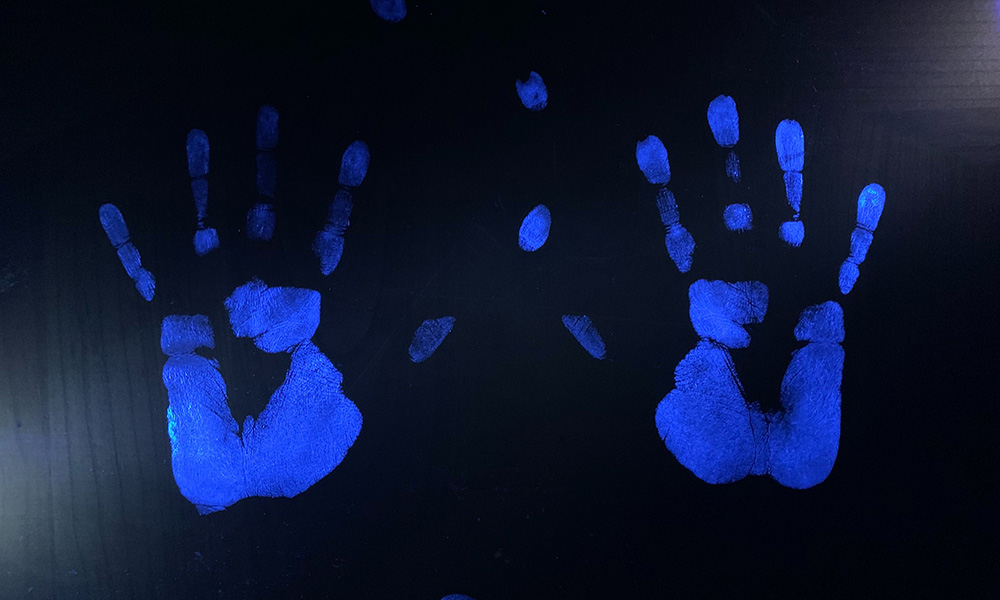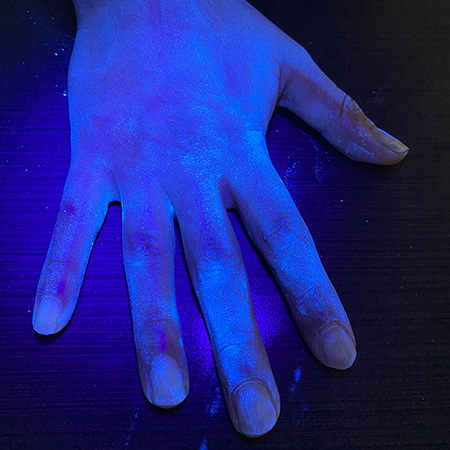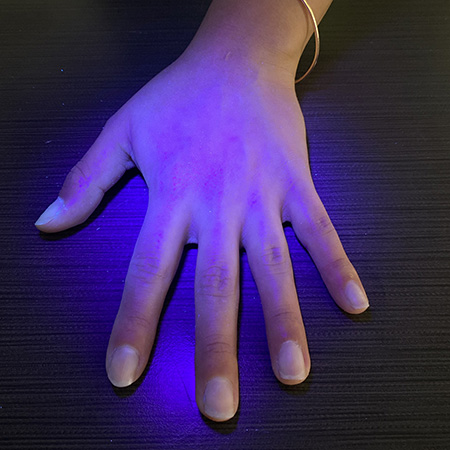
Illuminate the science behind key health recommendations to keep spreading germs at bay!
By now you have been informed that it is important to properly wash our hands often and to maintain physical distancing from others to help mitigate the impacts from COVID-19 (Coronavirus). However, it’s hard to combat something that you can’t see. So what exactly is the science behind how germs spread, and what can we do to help stay healthy both mentally and physically?
Lather, Scrub, Rinse and Repeat
Research shows that the new Coronavirus spreads primarily through droplets from an infected person’s saliva or nasal discharge when someone coughs or sneezes. These viral discharges can land on a surface and can live for days (depending on the surface material and location) on them if not properly disinfected. This means that doorknobs, counter tops and handrails can all be potential fomites – a contaminated object or material that can help spread the infection of a disease. Any time we touch a new surface our skin comes in contact with whatever may be living on that surface giving bacteria and viruses an opportunity to transfer to our skin.
To complicate matters, we all touch our faces. A lot! You probably just touched your face at the mention of it. A study in Australia found that medical students touched their faces an average of 23 times in one hour. It is a human habit that is difficult to break but when we touch our faces after touching a contaminated surface, the bacteria or virus that may be on our hands can enter our body through, especially though our eyes, mouth and nose. However, we can break the chain of transmission by disinfecting our hands through proper handwashing.
Normally, germs are invisible to us as they are microscopic organisms, but we have a trick up our sleeves to help show simulated germs. These germs, just like the real ones, are not easily seen so we used them to conduct an experiment to find out how easy (or not) it is to engage in proper handwashing. Please see below for a brief introduction:
Glo Germ powder, our simulated germs, mimics the way that germs spread. As it covers the hands it then transmits to any surface that the hands come in contact with; however, unlike real germs, Glo Germ powder glows under an UV (ultra-violet) light.
We tried to see what would happen if we scrubbed our hands under running water for about five to seven seconds. After inspection with a UV light we can see that the Glo Germ Powder is still very much present.

Then, we followed the CDC guidelines making sure to use running water, lather with soap and scrubbed for at least 20 seconds all over our hands, before rinsing and drying them fully. After careful inspection of under the UV light it worked, the hands were Glo Germ free!

The science behind why this works is a blend of chemistry and physics that together remove dirt and germs. Soap molecules are surfactants, meaning that they have a hydrophilic (water-loving) end and a hydrophobic (water-repellant) end as part of their composition that help break down oils and grease. Surfactants also influence how water behaves by reducing the surface tension of water and helping it spread more easily. As you lather and scrub your hands together you create friction. This resistance force helps lift dirt and germs off with the soap before they are ultimately rinsed off by the running water.
You can play with surface tension by trying our Building Bubbles Activity Toolkit and experiment with friction by trying our Friction Fun Activity Toolkit.
To visit the CDC guidelines on handwashing, please visit: https://www.cdc.gov/handwashing/when-how-handwashing.html
We All Need Some Space
Scientists measure the intensity of an infectious disease such as COVID-19 by its reproduction number, (R0). This is the average number of people a sick person will infect and for COVID-19 this number has been estimated at the end of February to be between 2 and 3 people. The higher the reproduction number, the quicker the disease is predicted to be able to spread and therefore the more people it has the potential to affect. This number is complex, not constant and based on an idealized scenario where nobody is immune to the disease. Various factors will play an important role in how the disease will ultimately spread including the environment, demographics and human behavior. So just how contagious is COVID-19? Comparatively, the new coronavirus is more contagious than the seasonal flu but less contagious than measles, for example.
The goal of public health officials when managing the spread of a disease is to lower the R0. A lower R0 means the spread of a disease is slowing down or stopping. Human behavior is a powerful tool to help lower a virus’ R0. The key is limiting people’s exposure to circulating germs which is best done if we stay at home and avoid large gatherings. This recommended behavioral change has been coined as “social distancing.” However, it is important to note that the World Health Organization recently reviewed and updated their phrasing from “social distancing” to “physical distancing.” This is because physical separation, which helps slow the spread of a disease by less people coming into contact with it, is recommended, social separation is not. Continuing to develop and strengthen social ties is key during this time for psychological wellbeing. And with the advancement of technology, we are all able to stay connected, virtually, more easily than ever before.
We all make choices every day that affect our health and happiness. Our decisions count and these choices have the power to impact not just our health but that our family and community. By staying at home when we can, each of us are helping to lower the R0, slow the spread of COVID-19, and keeping not just ourselves but our most vulnerable populations safe.
There are still a lot of uncertainties and developing news when it comes to COVID-19, we recommend staying informed through reliable public health sources like the ones below:
- What you need to know now about COVID-19 in Florida
https://floridahealthcovid19.gov - Cases & Latest Updates, Coronavirus Disease 2019 (COVID-19)
https://www.cdc.gov/coronavirus/2019-ncov/cases-updates/index.html - Coronavirus disease (COVID-19) Pandemic
https://www.who.int/emergencies/diseases/novel-coronavirus-2019
With the museum closed due to COVID-19, we are losing admission and event revenue that we so heavily rely on. Please consider making a tax-deductible donation to help offset the cost of animal care and virtual programming during this difficult time. All donations, however small, will have an immediate impact.
For questions on different ways to support Frost Science, please contact advancement@frostscience.org